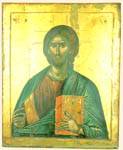|
|
| Portable Icons |
1542 Protaton Wood, egg tempera, 116 x 94 cm Cretan School |
|

|
This icon of Christ together with six others -of the Virgin, John the Baptist, the archangels Gabriel and Michael, and the Apostles Peter and Paul - which flank it in two symmetrical groups of three, compose the Great Deesis group on an iconostasis of the sixteenth century. With a further four, which would have depicted the Evangelists, all these icons constituted a wide, unified, rhythmically coherent, monumental composition, precisely dated to 1542 (Chatzidakis 1969-70, p. 326). Christ is portrayed frontally from the waist up, holding a bulky, closed, gemmed Gospel in his left hand and making a gesture of blessing with his right. He wears an aubergine tunic with a clavus and a deep blue himation. This physiognomical type, with the broad flat body and narrow shoulders, topped by a small head, is distinguished by a fine, long, narrow face rendered in sharp chiaroscuro with sharply defined areas that make it somewhat dry and cold. Despite some differences, it is a facial type that derives from Theophanis's works, such as the icons of Christ in the Great Lavra (Chatzidakis 1969-70, fig. 45), Pantokrator (Tsigaridas 1977 (3)), Iviron (Tsigaridas 1977 (1)), and Stavronikita (Patrinelis - Karakatsani - Theochari 1974, fig. 14). The difference consists chiefly in the softer modelling of the face in Theophanis's icons, which ultimately produces a difference in the ethos expressed: the face of Theophanis's Christ is serene, peaceful, and pensive, that of Christ in the Protaton icon more linear and restless, his inner state less carefully analysed. It is certainly not without significance that Chatzidakis compared the Protaton Christ with the fresco of Christ in the katholikon of the Great Meteoron (Chatzidakis 1969-70, figs. 47-8; see also Christ in the Baptism, in Chatzidakis - Sofianos 1990, fig. 127), for, on the basis of new data, the decoration of the Great Meteoron katholikon (1552) is now attributed to Zorzis (Chatzidakis 1987, p. 297). So, judging by stylistic criteria, this writer feels that the Protaton icon of Christ may also be attributed to Zorzis (see no. 2.53), who was probably an apprentice of Theophanis's on Mount Athos.
| |
|
Bibliography: Chatzidakis 1969-70, pp. 326-7, fig. 48.
| ||
| E.N.T. | ||
| Index of exhibits of Protato 16th century |
||
Reference address : https://www.elpenor.org/athos/en/e218ab48.asp